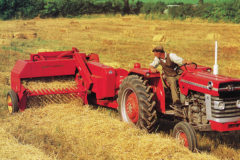Beautifully-restored Ferguson Mark 1 trailer
Posted by Chris Graham on 24th June 2020
Willie Carson takes a look at Colin Taylor’s beautifully-restored Ferguson Mark 1 trailer, which has been a prize-winner wherever it’s been shown.
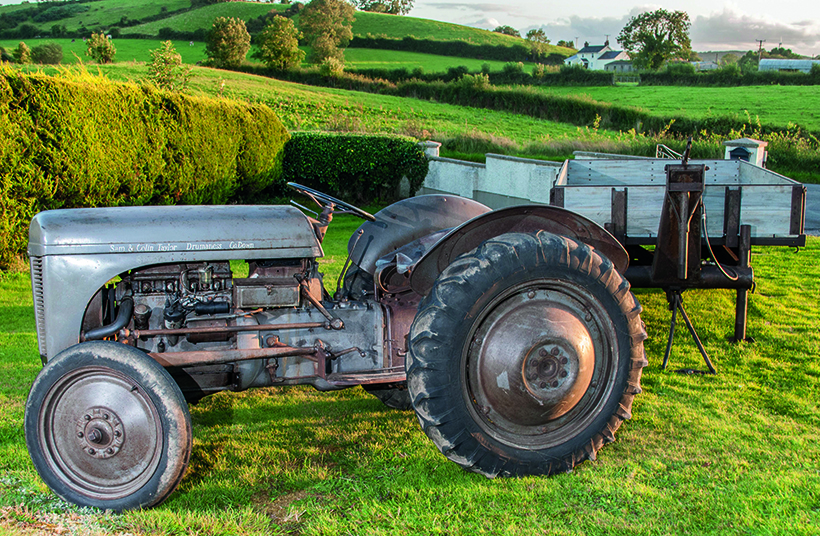
Beautifully-restored Ferguson Mark 1 trailer: This 1947 TE 20 is complemented by the Mark I trailer, which was produced until mid- 1947. The tractor is over 70 years old and fantastically original.
“A tractor without an implement is like a pen without ink.” In Harry Ferguson’s own words, this simple sentence put his concept of agricultural mechanisation into a nutshell. He designed the tractor, not just as a power source for pulling things, but also as the controlling mechanism for an integrated unit complete with an implement, which made the most of the tractor’s mechanical effort, taking efficiency to new levels.
Such was the success of the concept that he was able to devise an implement for just about every labour-intensive job on the farm. This ingenuity led to such an extensive list of machinery that entire books have been devoted to listing them, and explaining their design and use. Many people have fallen for the irresistible urge to buy and restore a Ferguson implement, but one is seldom enough.
Boyhood temptation
Colin Taylor gave into temptation early on in life. “I was about 13 or 14 years old when I bought my first TE 20, a 1955 TVO model,” he explained. “We brought it home that winter in the snow. My father had borrowed my uncle’s BMW to pull the transporter but, with it being rear-wheel-drive, it started to snake across the road and, eventually, it would go no further.
Luckily, though, we were only a couple of miles from home, so we took the wee Ferguson off the trailer and I drove it home from there, towing the BMW and the transporter!”
When the Taylors decided to give the tractor an oil change, they found that the filter housing was full of “what looked like top soil,” so it was obviously time for an engine rebuild. This was where Colin’s father Sam’s connection with Harry Ferguson’s business empire came in useful. When Sam was 16, he began an apprenticeship at Harry Ferguson Motors, an Austin dealership in Belfast. After a year on a bicycle as an errand boy, he started on the tools and trained as a mechanic, remaining in the same job, although the name above the door changed several times.
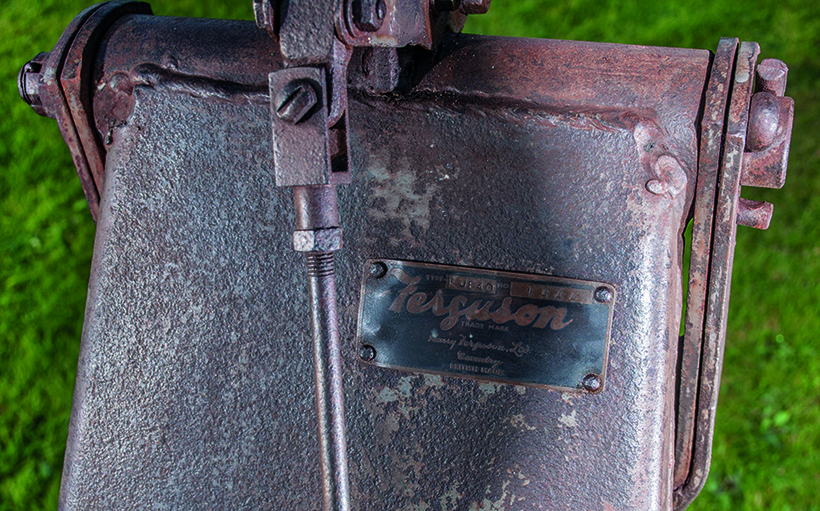
Even the trailer’s original plate and serial number have survived for over 70 years.
“Six or seven years later, we decided to give the tractor a full restoration,” Colin told me, “and then we went looking for some implements. We did a wee job for a neighbour, and took a two-furrow Ferguson plough in payment, so that was the start of it all. Then we bought another tractor – a 1954 TEF 20 diesel – and then a banana loader; it took us years to gather up all the brackets and pipes to make it work.
“Then, while searching on Gumtree, I saw a 1947 TE 20 with the Continental Z120 petrol engine, which had lived an easy life on a sheep farm in Larnarkshire. It had a transport box attached, and was used as a runabout when the sheep were being fed on an out-farm before lambing. It had been parked for 40 years and still had plenty of tread on the original tyres, so I didn’t waste too much time before I went across the water and bought it.”

The original timber was replaced with new planks, which were then distressed in keeping with the trailer’s patina.
Preserve rather than restore
“It was so original that I’ve decided to preserve it rather than restore it. The original tinwork is near perfect, and the engine runs like a clock; even the rim of the steering wheel looks like new. If you look at the old literature and films from the day, you’ll see the TE 20s leaving the factory with the wheel track set to 48in. This was the correct setting for ploughing with a Ferguson plough, so I set this one the same.”
When the TE 20 was in its heyday, no farm could operate efficiently without a trailer, and Sam and Colin’s collection reflects what was available from the Ferguson dealers at that time. “We bought a three-ton trailer, which needed a lot of work, and then found a 30cwt trailer on eBay. Since these are rare now, we bought that and set about restoring it. The chassis on those trailers is a box section design, and it rots from the inside, so it was a fairly major undertaking.”
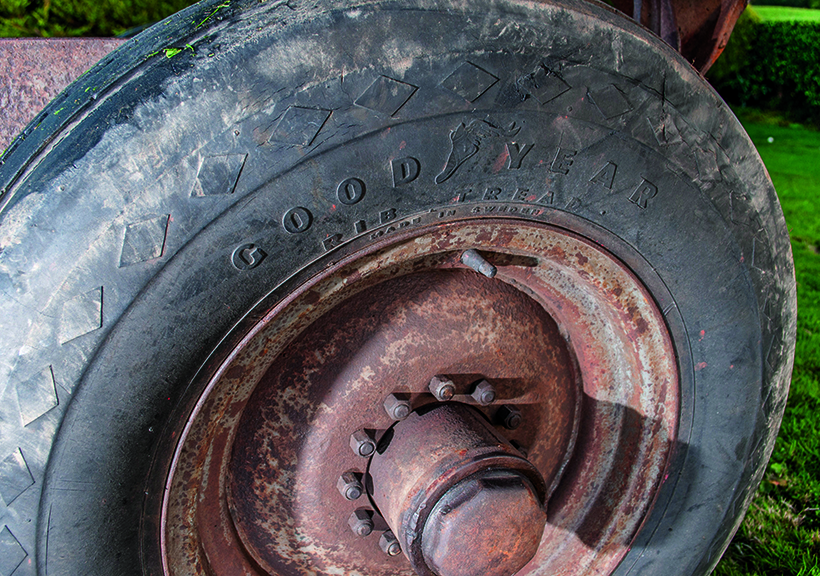
The trailer still wears the original close pattern ‘diamond’ Goodyear implement tyres.
Both of these trailers rely on the pick-up hitch for efficient weight transfer, the load being carried below the rear axle, rather than behind it, as on other tractors. Ferguson rose to prominence because of his concept of implement weight transfer, so it was natural for him to apply the same principles to trailer design. Before the concept of the pick-up hitch, his ‘Mark I’ trailer was designed with two separate connections to the tractor, one to carry the weight and the other to apply the pulling force.
Connected to the ‘long pin’ just below the draft control spring, the telescopic weight carrying attachment was angled such that the load was transferred to a point between the front and rear axles. This reduced the tendency for the tractor to rear up. At its lower end was a yoke, which permitted articulation when cornering. Attached between the yoke and the nine-hole drawbar was a solid bar, which held the bottom of the telescopic arrangement at a convenient angle for coupling the trailer to the tractor, and also prevented the arms from reaching the top of their travel and activating the pressure release – a necessary arrangement to allow the trailer to tip.
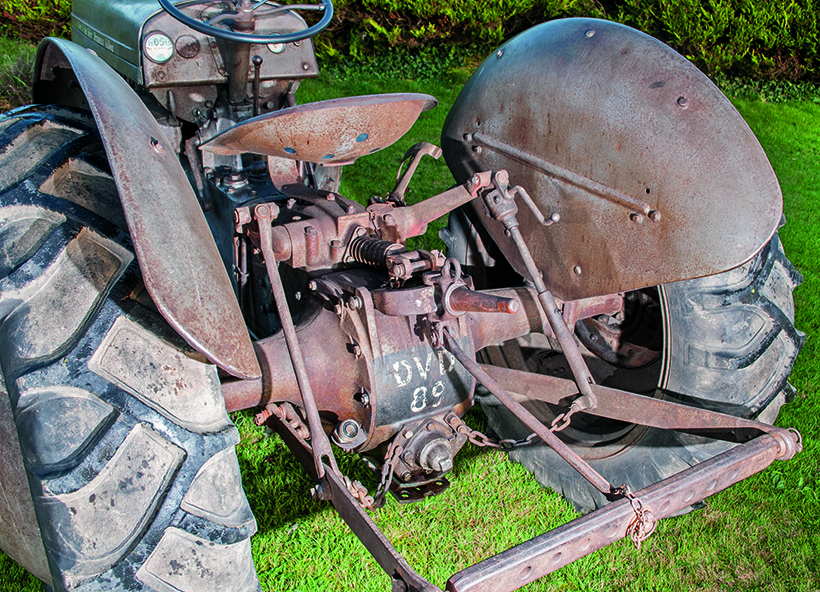
The upper link is pivoted to the yoke attachment, to provide articulation when cornering.
The trailer was towed by two rods, attached to the back axle via an articulate cross bar. Since there was no conventional drawbar and, therefore, nowhere to put a jack stand, two substantial, retractable legs carried the trailer when un-hooked. The arrival of the pick-up hitch in 1947 made the Mark I trailer obsolete overnight, and many were converted to incorporate a towing eye, either by the blacksmith or with a kit supplied by Ferguson dealers.

Ferguson’s hydraulic system proved its versatility when it was time to tip the trailer.
The French Connection
“I’d seen the early, Mark I trailer in books, but I’d never spotted one at a show, so I started to look for one. I found one locally which had been converted for a pick-up hitch, so all the original attachments were missing. I was looking for somebody to cast replacement parts when François Polain, a friend in Belgium, found a Mark I for sale in France, that was in original condition. I don’t speak French and the man selling didn’t speak English, so François translated all the communication. There were photos to show that all the parts were still with it, so I bought it.
“The steel work was rough in places, so I had to set some new metal into the tipping body, and fold new slots for the posts, which hold the sides. Other than that, the trailer was in good condition, so it seemed wrong to paint it and lose that originality. I made a mix of vinegar and bleach and sprayed it over the new metal, a wee bit every day until it matched the original patina. The floorboards aren’t joined by tongue-and-groove like the newer, three-ton trailers. They are individual boards, which slide in between steel load bearers, but the timber all needed to be replaced.
“There was some original paint on the underside, so I matched that and then distressed it. A lot of the original bolts for the floor were beyond saving, so I had buy new ones. To remove the zinc-plating, I burned them in a tin of diesel and let the Irish weather do the rest, and now you can’t tell the difference. We had plenty of help from a group of friends, unofficially called the ‘Toplink Club’, who gather here on a Monday evening.
“To connect it to the tractor you reverse in close enough to join the two telescopic parts of the upper link, then attach the lower links by pushing the pin upwards into the bracket, below the tractor’s back axle. It’s designed so that you just give the pin a quarter to lock it, but I drilled it to take an ‘R’ clip for peace of mind. To lift the weight off the two legs, you have to pull on the handbrake and reverse in sharply, to take the weight and lock an over-centre mechanism on the trailer chassis. You need the brakes to hold against the tractor properly, so they’re designed with a self-balancing linkage, which is a clever bit of Ferguson design.
“It was a good trailer in its day, but you’re on and off the tractor a few times before you have it all connected, so you can see why the pick-up hitch was designed. Since we finished it, the trailer has been used to cart bales and bags of corn, as well as doing the job of a makeshift dining table at local shows. We took it and the 1947 Continental TE 20 to Newark, in 2018, and came home with four awards, including the ‘Best Tractor and Implement Combination’ and the ‘Best Implement’ award from the Ferguson Club. That made it all worthwhile.”
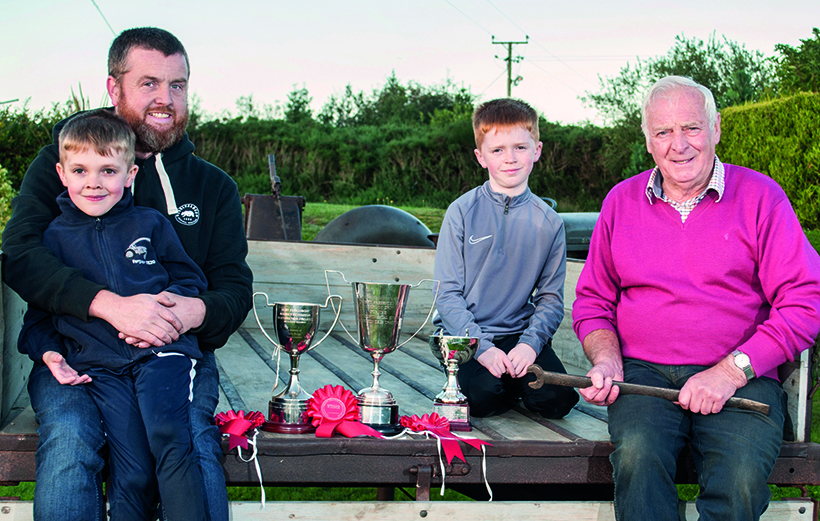
Colin, his father Sam and the next generation of Ferguson fans, with their silverware from Newark.
A tractor without an implement may be like a pen without ink, but Colin and Sam have re-written a chapter in Ferguson’s history with the restoration of this rare trailer.
To buy a money-saving subscription to Classic Massey & Ferguson Enthusiast magazine, simply click here




